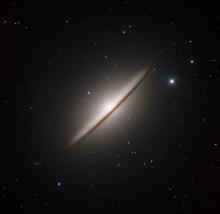Listen to today's episode of StarDate on the web the same day it airs in high-quality streaming audio without any extra ads or announcements. Choose a $8 one-month pass, or listen every day for a year for just $30.
You are here
Black-Hole Blobs
The black hole at the heart of the Milky Way galaxy is one of the quietest around. It’s not pulling in much material, so there’s nothing to heat up and produce light. Every once in a while, though, the black hole pulls apart an unlucky star, creating a powerful display of fireworks — including some “cannonballs” as big as planets.
The black hole is called Sagittarius A-star. It’s about 27,000 light-years away. It’s above the spout of the teapot formed by the bright stars of Sagittarius, which is low in the south at nightfall.
The black hole is about four million times the mass of the Sun — rather small for a galactic hub. It’s encircled by a thin disk of gas and dust, which emits a trickle of energy.
When the black hole grabs a star, though, it produces some major pyrotechnics. It rips the star to shreds, producing a torrent of energy. Some of the material enters the disk before it plunges into the black hole. But some of it, accelerated by the black hole’s powerful gravity, shoots back out into space.
Earlier this year, a study said that some of that hot gas coalesces to form blobs as big as planets. They’ve moving so fast that they’ll eventually leave the galaxy behind.
A few of these blobs could be passing through our galactic neighborhood. Right now, there’s no way to tell them apart from planets drifting through space on their own. But future telescopes might be able to track down these blobs from the Milky Way’s dark heart.
Script by Damond Benningfield





